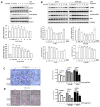Aspirin Inhibits Fibronectin Expression and Reverses Fibronectin-Mediated Cell Invasiveness by Activating Akt Signaling in Preeclampsia
- PMID: 36558974
- PMCID: PMC9781454
- DOI: 10.3390/ph15121523
Aspirin Inhibits Fibronectin Expression and Reverses Fibronectin-Mediated Cell Invasiveness by Activating Akt Signaling in Preeclampsia
Abstract
Preeclampsia is a severe gestational hypertensive disorder that may lead to maternal multiple organ dysfunction and adverse fetal outcomes. Aspirin provides a protective effect by reducing the risk of preeclampsia; however, its mechanism of action is unclear. Fibronectin (FN) is a key factor in cell motility and is associated with preeclampsia. Here, we demonstrated that cellular FN expression was elevated in the placenta of preeclamptic patients. The functional roles of plasma and cellular FN in trophoblasts were investigated by treating HTR-8/SVneo cells with exogenous recombinant human FN protein (rhFN) and siRNA, respectively. Trophoblast migration and invasion were inhibited by rhFN and facilitated by FN knockdown. Moreover, rhFN activated ERK and Akt signaling in trophoblasts, and FN-suppressed cell motility was rescued by ERK and/or Akt inhibitors. In this study, aspirin suppressed trophoblast cellular FN expression and reversed FN-mediated cell functions, including cell migration, invasion, and ERK/Akt signal changes. Taken together, the results of this study revealed the effects of FN on trophoblast motility and signaling; aspirin inhibits FN expression and reverses FN-mediated trophoblast biology. These results provide a drug mechanism for disease prevention and a target for preeclampsia intervention.
Keywords: Akt; aspirin; fibronectin; preeclampsia; trophoblast invasion.
Conflict of interest statement
The authors declare no conflict of interest.
Figures




Similar articles
-
Aspirin alleviates fibronectin-induced preeclampsia phenotypes in a mouse model and reverses fibronectin-mediated trophoblast invasiveness under hypoxia by regulating ciliogenesis and Akt and MAPK signaling.Biochem Pharmacol. 2024 Sep;227:116423. doi: 10.1016/j.bcp.2024.116423. Epub 2024 Jul 10. Biochem Pharmacol. 2024. PMID: 38996930
-
Aspirin enhances trophoblast invasion and represses soluble fms-like tyrosine kinase 1 production: a putative mechanism for preventing preeclampsia.J Hypertens. 2019 Dec;37(12):2461-2469. doi: 10.1097/HJH.0000000000002185. J Hypertens. 2019. PMID: 31335509
-
Aspirin facilitates trophoblast invasion and epithelial-mesenchymal transition by regulating the miR-200-ZEB1 axis in preeclampsia.Biomed Pharmacother. 2021 Jul;139:111591. doi: 10.1016/j.biopha.2021.111591. Epub 2021 Apr 14. Biomed Pharmacother. 2021. PMID: 33865015
-
Low-dose aspirin prevents LPS-induced preeclampsia-like phenotype via AQP-1 and the MAPK/ERK 1/2 pathway.Placenta. 2022 Apr;121:61-69. doi: 10.1016/j.placenta.2022.03.007. Epub 2022 Mar 5. Placenta. 2022. PMID: 35279428
-
Tissue Transglutaminase Impairs HTR-8/SVneo Trophoblast Cell Invasion via the PI3K/AKT Signaling Pathway.Gynecol Obstet Invest. 2021;86(3):264-272. doi: 10.1159/000515086. Epub 2021 Jun 17. Gynecol Obstet Invest. 2021. PMID: 34139701
Cited by
-
Prediction Models for Late-Onset Preeclampsia: A Study Based on Logistic Regression, Support Vector Machine, and Extreme Gradient Boosting Models.Biomedicines. 2025 Feb 3;13(2):347. doi: 10.3390/biomedicines13020347. Biomedicines. 2025. PMID: 40002760 Free PMC article.
-
Extracellular matrix and pregnancy: functions and opportunities caught in the net.Reprod Biol Endocrinol. 2025 Feb 14;23(1):24. doi: 10.1186/s12958-025-01348-5. Reprod Biol Endocrinol. 2025. PMID: 39953593 Free PMC article. Review.
References
Grants and funding
LinkOut - more resources
Full Text Sources
Miscellaneous

